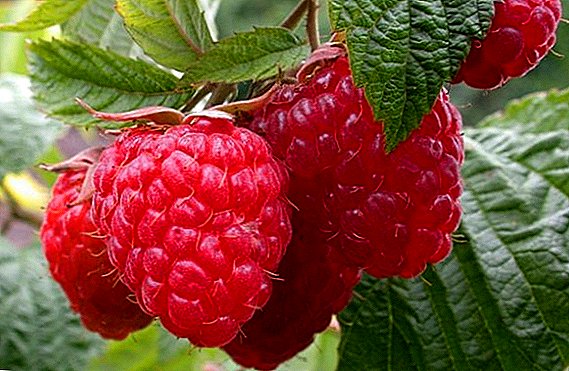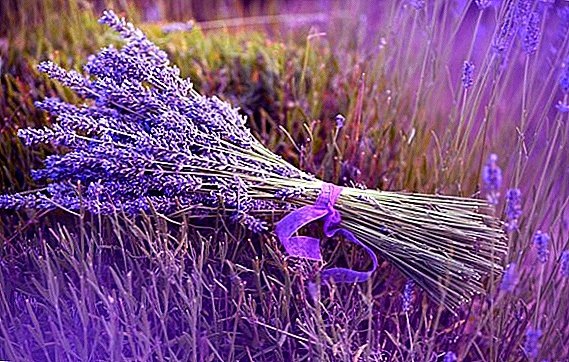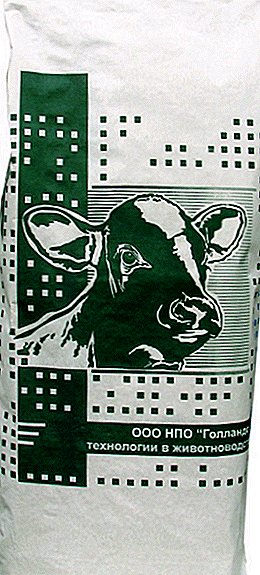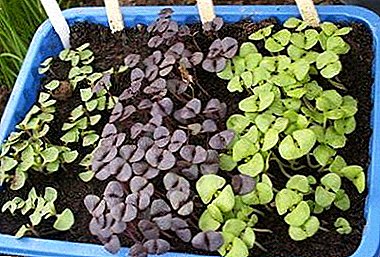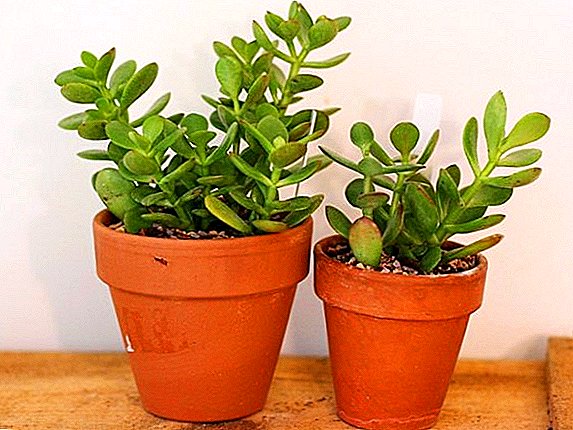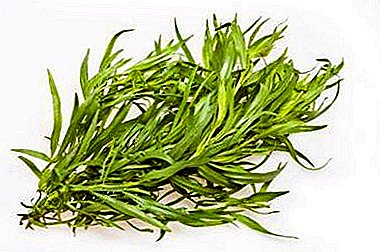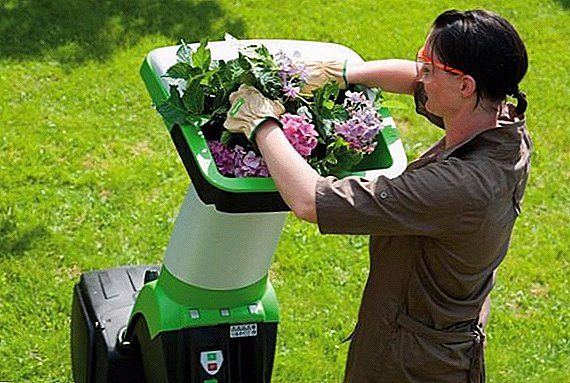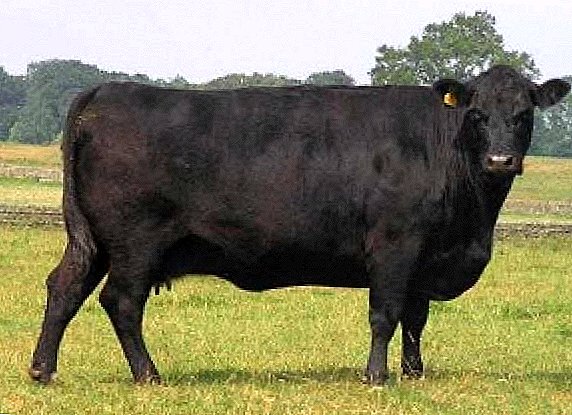 The desire for diversity and the desire to surprise friends and relatives, having grown on the site not only red tomatoes, but also their colorful varieties - quite understandable. Now the color scale is represented by pink, yellow and even dark fruit. This issue, as well as a number of others related to crop rotation, yield, and the use of tomatoes for medicinal purposes, are solved by selecting varieties.
The desire for diversity and the desire to surprise friends and relatives, having grown on the site not only red tomatoes, but also their colorful varieties - quite understandable. Now the color scale is represented by pink, yellow and even dark fruit. This issue, as well as a number of others related to crop rotation, yield, and the use of tomatoes for medicinal purposes, are solved by selecting varieties.
Tomato "Chernomor" refers to dark fruit varieties because its fruits have a characteristic dark color. The variety belongs to the category of mid-ripening and can be grown both in open ground and in the greenhouse.
Variety description
"Chernomor" is a mid-ripening variety of tomatoes that grows equally well both in the open field and in the greenhouse. 
The main advantages of the variety:
- gives a good harvest, even with minimal care;
- possesses high tastes;
- characterized by a long period of abundant fruiting;
- has dense and sluggish fruits that tolerate transportation.
Accelerated ripening is characteristic for the variety - Chernomor ripens in 110 days, while usually ripening tomatoes ripen about 120 days. The variety is moderately resistant to diseases.
Tomatoes of mid-season varieties are well suited for preparations for the winter: canned tomatoes, salads, mixed vegetables, ketchup, juices.
Learn what else you can cook from tomatoes, how to make jam, how to freeze properly, how to make ketchup, tomato juice, tomato salad, tomato paste.
A distinctive feature of mid-ripening varieties is their high yield: 3-4 kg of fruit from a bush. Hothouse form of cultivation with good watering and adherence to the feeding schedule can produce up to 7 kg of juicy fruits of lilac color. 
The shape of the tomatoes is round, ribbed at the stem. The harvest of ripe tomatoes can be stored for more than 15 days without processing. Sort distinguishes good transportability.
Chernomor is a semi-determinant variety that reaches a height of 1.5-2 m, which is very good for greenhouses. The ovaries are formed over the entire height of the plant, so this tomato needs pasynkovanii and forming a bush.
Important! To make tomatoes your diet from spring to late autumn, grow varieties with different ripening periods. It is preferable to plant 35% of early ripe tomatoes, 45% of middle-ripening and 20% of late-ripening varieties.
Fruit characteristics and yield
Fruits "Chernomor" dark color, large, rounded. In the stalk the tomato is slightly ribbed. Fruit weight is 150-200 g. Individual specimens can reach 500 g. Tastes are high: the fruit is sweet, juicy, fleshy. 
Seed chambers are large with a large number of seeds. Fruits can be picked selectively - once every 3 days in the stage of blank, initial and full ripeness.
The nutritional value of "Chernomor" is manifested in taste properties, the presence of sugars, a complex of vitamins A, C, B1, B2, PP, potassium, iron, phosphorus.
Selection of seedlings
If it is not possible to grow the seedlings independently, then when buying in the market, one should take into account the following factors:
- Take plants from several vendors. Even an experienced vegetable grower will not be able to identify a tomato variety by leaves. Therefore, if you are deceived with a variety at one point, then it will be only some of the acquired plants.
- Signs of healthy seedlings: a thick trunk, well-formed 6-7 leaves, without signs of damage by pests, stably standing in the container. If the trunk is thin or the plants are elongated - such seedlings, most likely, have not been tempered or dived, so it will be bad to take root.
- Plant height is about 30 cm.
- You should not take very lush seedlings - it was overfed with nitrogen fertilizers. It will take root well, but the fruit will be bad.
- It is not recommended to buy seedlings with ovaries. This means that it has outgrown a little. If the ovary is small, just cut it to allow the plant to settle well.

Did you know? The phytoncides contained in tomatoes block the activity of pyogenic microorganisms. Tomato pulp gruel is used to treat wounds and ulcers.
Soil and fertilizer
Vegetables grow well on alkaline soil, as well as loose, nutrient-rich, sandy or loamy type. To develop the root system, tomato needs high-quality aeration, which only loose soil can provide.
During the growth period, the plant uses potassium and nitrogen, and during fruiting it needs phosphorus.
On the plots from the annual use of soil depleted and oxidized. Therefore, before planting, it is imperative to work to improve the composition of the soil. 
Technique of:
- The soil in the greenhouse or on the site necessarily digging. Clods of earth are broken.
- If the soil is acidic - to neutralize it, make ash, slaked lime, chalk or dolomite flour. On acidic soil, the plants will be weak with low yields, highly susceptible to rot infection.
To check the acidity of the soil, place a spoonful of soil from the future garden bed into a plastic container, add a spoonful of vinegar there and stir until the consistency of sour cream. Alkaline reaction is manifested by air bubbles: the more alkaline the soil, the more bubbles. If there is no reaction, then you have a sour soil.
Did you know? Soil liming is performed by mixing the upper soil layer (15 cm) with lime. If you just scatter lime on the site, then the calcium contained in it gets to the plants completely no sooner than by the next season. It is necessary to carry out the procedure at least once every 3 years.

Make a means for deoxidation should be 1-2 weeks before planting plants on the bed. For lime, the spread rate will be as follows (g / sq. M):
- sour soil - 500 g;
- medium acid - 400 g;
- weak acid - 300 g
If you are deoxidizing with chalk, then the rate of application is as follows (g / sq. M):
- acidic soil - 250 g;
- medium acid - 200 g;
- slightly acid - 150 g
A week after the deposit, trenches or holes are prepared for planting. Elements necessary for tomatoes are brought in a landing trench.
To feed the plants, nitrogenous, phosphate and potash fertilizers are applied to the soil in the following amount (g / sq. M):
- nitrogen - 30 g;
- phosphorus - 12 g;
- potassium - 45 g

White cabbage and cauliflower, onions, corn, and parsley are good tomato precursors. Tomatoes suffer from the same diseases as eggplants, potatoes, peppers. Therefore, tomatoes should not be planted after them.
Crop rotation is necessary, since the same crop or a diet similar to it, depletes soil reserves and contributes to the reproduction of pests.
Did you know? One of the first countries to use fertilizers was ancient Japan. And the first fertilizers are human waste products. At the same time, the feces of rich people were very expensive, since it was assumed that it had a higher content of nutrients.
Growing conditions
Tomatoes are thermophilic. Seeds germinate at +10 ° C, and the optimum temperature for growth is + 20 ... +28 ° C. Plants do not tolerate frosts, so they can land in open ground no earlier than early May, when the morning soil frosts end. 
Before fruiting, tomatoes are fairly drought-resistant — the optimum soil moisture is 70%. With a lack of moisture begins to fall ovary. Tomatoes are plants of short daylight and intense light.
Grow well with a long and uninterrupted day, but at the same time they delay development and fruit formation.
Planting seedlings in the ground is carried out in wide rows with a distance between them - 50 cm, and between plants - at least 30 cm. After planting, the maintenance consists in loosening the soil, removing weeds, watering and feeding.
Growing from seed to seedlings at home
For growing seedlings prepare a nutrient mixture of turf land and humus, taken in equal quantities. To this mixture add 0.5 liters of wood ash to prevent the acidity of the soil. 
If you grow tomatoes annually, then it would be right to stock up on seeds for planting from the previous season's crop. If seeds need to be purchased, then buy them in specialized stores.
So you can be sure that the inscription on the package and the seeds inside are the same variety. Good germination have seeds a year ago - they have a specific tomato smell. Do not purchase goods in packages without shelf life, crumpled and having various defects.
Important! Store seeds should be in a heated room. Long stay at sub-zero temperatures reduces their germination by 50-60%.
Seed preparation
For germination take healthy yellow seeds. First of all they are treated with hot water at a temperature of +60 ° C. You can warm the seeds with a table lamp at the same temperature. The purpose of this operation is disinfection from possible infection with pathogenic microflora during storage. 
For disinfection, seeds are also treated with a 1% solution of manganese potassium for 24 hours.
Seed soaking is performed at a temperature above +22 ° C. Wet seeds in a container covered with wet gauze or bandage. The mesh surface well retains the necessary moisture and perfectly passes oxygen. It is also recommended to harden the seeds.
Hardening mode: 19 hours in the refrigerator, and then 5 hours in the room. Hardening time - 5 days.
Content and location
After hardening, seeds are sown in boxes. A week before landing, the containers with the ground are heated indoors at room temperature. In this case, the soil is poured abundantly with a 1% solution of manganese potassium. 
Part of the seedlings after transplantation is killed, another part will die from various pests after planting ready-made plants in the ground. Therefore, seedlings are always grown by 30% more than necessary.
Did you know? Amino tomatoes are aphrodisiacs that stimulate the sexual energy of men. The taste of these tomatoes is more intense, and the aroma is more complex.
Seed planting process
The seeds are sown with a distance between the rows of 3 cm, between the seeds - 2 cm. From above the seeds are sprinkled with a layer of earth (2 cm). After planting, pour the contents of the box out of the watering can and cover with a film for 3-4 days. Shoots appear on day 7-10.
During growth, seedlings are fed twice with a nutrient solution in the ratio:
- superphosphate - 30 g;
- potassium chloride - 20 g;
- ammonium nitrate - 20 g;
- water - 10 l.

Landing in the ground occurs at 50-60 days of growth.
Care of seedlings
To ensure good growth plants need to be lit at least 10 hours a day. To arrange uniform lighting, use fluorescent lamps. Do not use only natural light - the plants will reach towards the source of light and the trunks will be too elongated.
The daytime temperature for seedlings should not fall below +20 ° С, ideally it should be at the level of + 22 ... +26 ° С. Night - not below +17 ° С. Watering is carried out every five days with a watering can.
The first pick is carried out after the appearance of the third true leaf. Seedlings are seated in cups. The stalk is immersed in the ground until the seedbed leaves. This will create a powerful root system. 
The second pick is performed in larger cups after 3 weeks. When planting the cotyledon leaves are removed. At the same time carry out feeding.
Transplanting seedlings to ground
In the ground tomatoes are planted in early May for 50-60 daysin sunny windless weather.
For planting, the plant from the cup is transplanted together with the soil into the wells or into the planting trench to the same depth that was at the time of growing the seedlings. If the plant is stretched during growth, you can plant it under the slope so that part of the trunk fit into the trench.
This part will sprout by roots that will help a plant to become steadier. The distance between individual plants in a row is 30 cm, between rows is at least 50 cm. 
Did you know? Not all dark-fruited tomatoes have a pronounced black color. Most are colored in dark red and brown shades. Fruits of this color are called Kumato. "Chernomor" - one of these varieties.
Agricultural technology of growing tomato seeds in the open ground
It is possible to grow seeds both in open ground and in greenhouses. When grown under natural conditions, it is necessary to take into account the effect of temperature on growth, yield and feeding features of such tomatoes.
To get a timely harvest, it is imperative to cover the plants at night and on cool rainy days. And when applying fertilizers - to process not the entire area of the site, but to deposit them exactly in the area of the root system.
Outdoor conditions
Tomatoes are very thermophilic plants that develop poorly in cold weather. And spring in our latitudes is characterized by sudden changes in day and night temperatures. 
Therefore, in order to get a good harvest of tomatoes in time, the plants need to create comfortable conditions for development, that is, the night temperature is not lower than +17 ° C. This is only possible with a greenhouse or greenhouse.
Modern materials for greenhouses perfectly adjust the night temperature, and also allow plants to receive a sufficient amount of light. Tomatoes are also very light-requiring. Therefore, their planting should be no closer than 1.5 m from buildings and as far as possible from trees.
The process of planting seeds in the ground
Tomato seedlings are planted in open ground in early May after the end of soil frosts. Fertilizers are applied to the excavated deoxidized soil. If planting is carried out in the wells, then fertilizers are applied to each.
If planting takes place in a planting trench, then fertilizers are evenly distributed along its entire length. 
So much water is poured into the plant well to make the soil creamy. The sprout is placed in it along with the soil in which it grew.
Liquid soil will allow the roots to turn around well and begin to take root. After the excess moisture is absorbed, the wells are covered with humus, peat or dry earth. After 2-3 days, watering is done again and new plants are planted instead of those that are not started.
If the planting is carried out with germinated seeds, then they are placed in a trench by a belt method. Before placing the seeds, the soil is watered, and then sprinkled with earth so that the ground cover thickness is 2 cm.
Cover sowing film with a margin on the sides. After the emergence of seedlings, the film coating is raised so that a small greenhouse is formed. 
This design improves the temperature regime and contributes to the accelerated germination and acclimatization of plants.
Young tomatoes that grow in the open field do not need a dive. Some plants may have to be removed if the seeds come out too thick, or transplanted if they have not grown in some part of the row.
Did you know? If plants are grown in a greenhouse, they are covered with a film for the night, and during the day they remove the film coating. On cold rainy days, the cover is not removed.
Watering
In the spring the soil contains a lot of moisture. In addition, tomatoes to the fruiting stage tolerate drought well. Therefore, watering is necessary when the soil begins to dry out. In hot sunny weather, water should be watered at least once a week. Irrigation rate: 40-50 liters of water for 6-8 plants. 
Water temperature should not be below +14 ° С. It is impossible to direct a stream of water to the plant or to the roots. When the soil is washed out from under the root, the tomato will lose stability, and the excess moisture on the leaves will attract insect pests.
Soil loosening and weeding
Loosening is carried out as needed and after each watering. As the root system forms close to the ground, it is recommended to cover the soil after watering with sawdust or mulch. The depth of tillage is 4-8 cm.
Tasks loosening:
- provide aeration of the root system;
- weed control;
- eliminating the larvae of pests that live in the soil.
You can loosen a garden hoe, an electric or mechanical cultivator. If the weather is rainy - then loosening is carried out after the soil dries. 
Masking
Removal of young shoots, which are formed in the leaf axils, is called pasynkovaniem. This procedure plays an important role in the formation of the bush. The buttocks are removed when they reach 3-4 cm, leaving a small stump up to 1 cm.
Learn how to properly seed tomatoes in a greenhouse, as well as in the open field.
The butchers break off gently with their fingers. A plant without side shoots produces larger fruits and higher yields. This is possible due to the fact that nutrients are sent to the fruit and are not spent on the growth of additional non-fruitful shoots. 
Garter
When plants reach a height of 20-30 cm, they are tied up to a trellis or to pegs. Tying to a horizontal trellis is most commonly used.
Chernomor can reach heights of up to 2 m, so in the greenhouse this variety is tied up to a vertical trellis, which is the attachment of tomatoes to the greenhouse ceiling on a cord. As the plant grows, the cord is tightened.
Learn how to tie up tomatoes in an open ground, and how in the greenhouse, how to use clips for a garter.
The task of tying up - evenly distribute the weight of the fruit on the plant. One bush "Chernomor" can produce about 4 kg of tomatoes in open ground and up to 12 kg in a greenhouse.Therefore, tying is necessary to relieve pressure on the trunk and twigs.
The main types of designs for garters:
- horizontal trellis;
- vertical trellis;
- metal or wooden pegs;
- small fence around the plant;
- garter to hedge.

Did you know? Tomatoes are pollinated without insects, but with the help of wind. If your tomatoes grow in the greenhouse, then to get a good harvest they need to be pollinated with the help of active ventilation. You can also tap the twine tied to each plant with a stick.
Top dressing
The first feeding is carried out 10-15 days after planting, the second - at the beginning of flowering, the third - in the period of fruit set.
For feeding use:
- ammonium nitrate - 15 g;
- superphosphate - 20-30 g;
- potassium sulphate - 15-20 g;
- water - 10 l.
Top dressings bring under a root in the damp soil. The next watering is carried out after 7-10 days after feeding. 
Pests, diseases and prevention
Variety "Chernomor" susceptible to late blight. The disease manifests itself in the form of brown spots on the leaves and fruits. The first spraying Bordeaux liquid against the phytophtoras is carried out when the ovaries begin to appear.
After 2 weeks, spraying is repeated. The third spraying is carried out with a solution of garlic. To do this, 50 g of garlic is crushed, pour 1 l of water and infused for 12 hours. Dilute with water to 10 liters and spray the plants.
To prevent infection, the plants are sprayed with "Phytosporin". Already infected tomatoes are treated with Famoxadone and Mefenoxam.
Other types of bacterial contamination:
- mosaic;
- blackleg;
- brown spot;
- different types of rot.

Pathogens, as a rule, exist in the environment constantly, but are activated only when favorable conditions occur. Those for the development of late blight and other diseases is the increase in humidity after heavy rain or watering.
Important! Do not exceed the permissible dosage of chemicals. Even low-toxic drugs are toxic to humans. It is also impossible to eat fruits if the chemical treatment of plants occurred less than 20 days ago.
Mosaic appears as whitish spots on the leaves and fruits. Tolerated by aphids. There is no effective way to deal with it, so the affected parts of the plant are destroyed. Black leg or root rot is manifested in the form of blackening of the stem of the plant, followed by wilting.
As a measure to prevent the development of the disease, spraying is carried out with “Pseudobacterin-2”.  Brown spotting is treated by spraying fungicides.
Brown spotting is treated by spraying fungicides.
Such drugs as “Scor”, “Switch”, “Thanos”, “DNOC”, “Fundazol”, “Signum”, “Cumulus”, “Healer”, “Alette”, “Merpen” are considered as fungicides.
The most dangerous insect pests are those that gnaw the root system, leading to the death of the plant. These include the Maybot and Medvedka larvae.
Among the ways to combat soil pests are the following:
- digging the soil;
- the construction of special traps for pests;
- the use of toxic substances.
Leaf pests are sprayed. For example, the drug Proteus is used against aphids. Spraying is carried out in dry, windless weather in several stages with an interval of 3-5 days.
This is due to the fact that new pests can hatch out of their eggs in a few days or the following can fly.  This is especially true in cases where pests are flying to your tomatoes from another area.
This is especially true in cases where pests are flying to your tomatoes from another area.
Harvesting and storage
Harvesting can be carried out as the fruit ripens every three days. The stage of maturity "Chernomor" enters 110-120 days after landing. For storage the crop is laid in boxes. Place the fruit in a dry ventilated area.
It is undesirable to put tomatoes in more than three rows, as due to the large specific gravity of the lower tomatoes can be damaged. Try to lay down heavier and larger fruits. Layers can be transferred by paper or heat insulating material.
Did you know? It should be borne in mind that tomatoes continue to grow even when torn, so they cannot be laid too tightly.
Only intact fruits with no signs of disease are placed in storage. You can save ripe tomatoes for about 3 weeks. Unripe fruits are stored for a long time. Wash tomatoes should be immediately before eating. 
Possible problems and recommendations
Good conditions for growth and fruiting - the key to your harvest. In order to enjoy high yields, feed the plants in a timely manner and control the conditions in which they grow: humidity, temperature, the appearance of pests.
And also carry out timely agrotechnical measures: fertilization, loosening the soil, watering, ventilation (for greenhouse plants).
Falling flowers, leaves or fruits can be a problem for the future harvest. The first sign of falling off of the ovaries or leaves is a lack of moisture in the soil and nitrogenous fertilizers. In addition, plants shed their leaves in low light conditions or as a result of fungal diseases.
Being a light-loving plant, the tomato does not tolerate shade from the trees or too thick planting. Remember that densely planted plants - this is not a guarantee of high yield, but a high probability of its decline due to cramped and shaded. 
When the ovary falls off, conduct additional plant nutrition. If the fruits fall, it can mean that the plant is affected by some kind of rot. Treat the bushes with a mixture of copper sulphate, zinc and urea.
As you can see, the care of tomatoes is not very complicated. Its main rule is the timeliness of agrotechnical measures. From this depends on the yield of plants. Grow Chernomor in the open field or in greenhouses and enjoy high yields.


